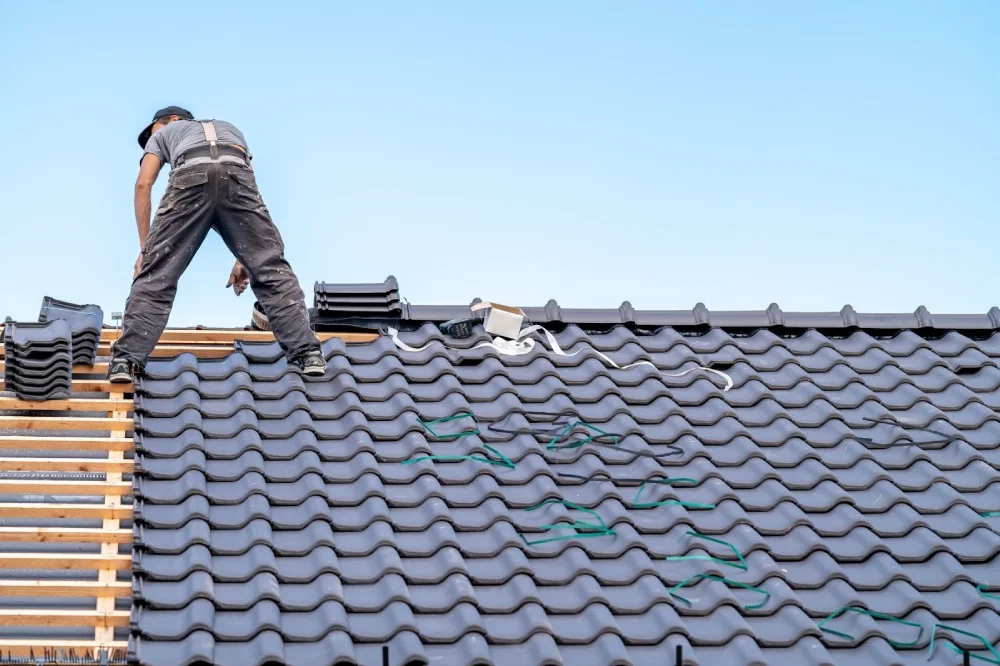
Choosing the right roof requires evaluating climate conditions, budget constraints, and structural requirements. Homeowners should consider material longevity, with options ranging from affordable asphalt shingles to premium slate or metal roofing. Energy efficiency factors significantly impact long-term costs, particularly in extreme climates. Aesthetics should complement architectural style while meeting regional weather demands. The ideal roofing solution balances initial investment against durability, maintenance needs, and potential energy savings.
When selecting a roof, homeowners must carefully consider their local climate conditions, as regional weather patterns significantly impact material performance and longevity. Different environments demand specific roofing solutions: hot regions benefit from reflective materials like clay tiles, while cold areas require options that withstand snow loads, such as asphalt shingles or slate.
Humid locations need algae-resistant materials and proper ventilation to prevent moisture damage. Standing seam metal roofing provides superior wind resistance in areas frequently hit by storms and hurricanes. Coastal areas require materials like treated wood shingles that resist saltwater corrosion while maintaining durability in high humidity environments. In storm-prone regions, impact-resistant certifications and high-wind ratings are essential for safeguarding against severe weather. As climate change intensifies extreme conditions, roof material performance becomes increasingly critical.
The selection of an appropriate roofing material represents one of the most consequential decisions homeowners face during construction or renovation. Each option presents distinct advantages in terms of durability comparison, visual appeal, and long-term performance. While asphalt shingles offer budget-friendly solutions with decent wind resistance, stone-coated metal roofs deliver superior longevity and significant resale value impact through their 40-80 year lifespan and energy efficiency. Architectural asphalt shingles provide excellent value with their highest warranties compared to standard options.
Understanding these material differences equips homeowners to balance immediate budget constraints against long-term performance benefits.
Homeowners considering roof replacement or installation face a fundamental question that extends beyond mere material selection: what represents the best financial decision over time?
When conducting a payback period analysis, it becomes evident that higher upfront costs often translate to superior value. Asphalt shingles ($4-$6 per sq.ft) may initially seem economical but require more frequent replacement compared to metal roofing, which delivers an 85.9% ROI through energy efficiency and durability. Premium materials like slate and copper, while expensive initially, eliminate replacement costs for multiple decades.
Insurance premiums implications further complicate the equation, as fire-resistant materials like metal can lower ongoing costs. Climate considerations also affect long-term value—metal performs exceptionally in snow-prone regions, while humidity-prone areas benefit from algae-resistant or non-porous options. The true investment value emerges when matching material longevity with specific property needs.
Proper roof selection requires careful assessment of weight-bearing capacity to accommodate various roofing materials, from lightweight asphalt shingles at 3 psf to heavy clay tiles reaching 27 psf. Engineers must validate structural compliance against building code Table 601, ensuring roof assemblies can support both dead loads and anticipated live loads during installation and maintenance. Installation complexity increases proportionally with roof weight, often necessitating specialized equipment, additional structural reinforcement, and skilled labor trained in handling material-specific challenges.
Understanding a roof's weight-bearing capacity stands as one of the most essential yet overlooked aspects of roof selection. Most residential roofs must support 10-20 psf dead load and 20-40 psf live load, with building codes typically mandating minimum requirements. Roof design considerations should account for material type, span length, and local climate conditions when calculating structural load verification.
Regular inspections are vital as age and deterioration reduce capacity over time, potentially compromising structural integrity and risking collapse under heavy loads.
Beyond weight-bearing calculations, the installation of a roof system demands specific equipment considerations that impact both safety and structural outcomes. Proper installation requires specialized tools including roofing nailers for efficient shingle attachment, circular saws for precise cuts, and utility knives for underlayment trimming.
Safety precautions are non-negotiable, with harnesses, hard hats, and non-slip footwear being essential to prevent accidents. Equally important are structural assessment tools like chalk lines and tape measures that confirm accurate material placement and alignment.
Material handling techniques significantly influence installation quality. Proper debris management using tarps and dumpsters protects property, while appropriate surface preparation with brooms and self-adhesive underlayment guarantees waterproofing integrity. Contractors must secure proper equipment access, including ladders or aerial lifts, particularly for complex roof geometries.
Modern roofing technologies offer significant energy efficiency benefits through cool roof solutions that reflect solar radiation and reduce cooling costs. Sustainable material choices like metal roofing and clay tiles provide extended lifespans, minimizing waste and replacement frequency while offering excellent thermal properties. These environmentally conscious options may require higher initial investments but typically deliver substantial long-term savings through reduced energy consumption and maintenance requirements.
While the initial cost of a new roof often dominates decision-making, cool roofs deliver exceptional long-term value through their extraordinary energy efficiency and environmental benefits. These high-performance systems reflect sunlight rather than absorbing it, resulting in superior cool roof performance across multiple metrics. Studies show they can reduce energy consumption by up to 16.6% and lower indoor temperatures by 1.2-3.3°C in non-air-conditioned buildings.
The selection of sustainable roofing materials significantly impacts both energy efficiency and environmental footprint throughout a building's lifecycle. Green roof systems offer impressive cooling load reductions of 70% while metal roofs reflect 85-90% of sunlight, potentially saving 40% in annual energy costs. Both options present long-term economic advantages despite higher initial investments.
Recycled materials innovations have produced durable shingle substitutes from rubber, plastic, and wood fibers that divert waste from landfills while providing comparable performance to traditional options. Though some recycled products may lack sustainability certifications, their environmental benefits remain substantial. Clay tiles offer exceptional longevity exceeding 50 years with minimal chemical processing, while solar-integrated systems combine weatherproofing with renewable energy generation, optimizing roof functionality and reducing grid dependency.
When homeowners invest in a new roof, they often overlook the critical maintenance requirements that significantly impact its longevity and performance. Proper maintenance scheduling through biannual inspections can extend roof life by up to 8 years, with proactive cost benefits of 11 cents per square foot annually compared to reactive approaches. A well-maintained roof lasts 21 years versus just 13 years with reactive strategies.
Climate considerations should guide maintenance decisions, as coastal properties may require more frequent inspections than inland homes.
Selecting the perfect roof involves more than durability and cost considerations—designer harmony plays a decisive role in maintaining a home's aesthetic integrity and market value. Each architectural style demands specific roofing elements that complement its unique characteristics.
Modern homes thrive with flat or low-slope roofs, metal materials, and clean lines, while colonial designs call for symmetrical gable or hip structures with traditional asphalt or cedar shakes. When considering architectural details of craftsman bungalows, steep-pitched roofs with exposed beams create authentic charm. Historical Victorian and Tudor homes require ornate, complex rooflines, often utilizing slate or clay tiles while prioritizing historical accuracy. Regional styles like ranch and farmhouse benefit from simpler profiles with earthy palettes that harmonize with natural surroundings.
The right roof doesn't just protect—it completes your home's architectural narrative.
At TriStar Built, we believe that selecting the right roof requires careful consideration of climate, material durability, budget, and aesthetics. Homeowners should prioritize long-term value rather than focusing solely on upfront costs. Our professional consultation ensures structural compatibility and expert installation. A thoughtfully chosen roof not only safeguards your home for decades but also improves energy efficiency and complements your property’s architectural design — all while potentially increasing its market value.
DIY skills frequently transfer to maintenance tasks, enhancing problem-solving abilities, tool proficiency, and time management. These transferable skills can increase home equity and provide improved curb appeal through consistent property upkeep.
Insurance policies typically exclude DIY work, creating liability concerns for homeowners. Contractor work shifts risk to professional policies, requiring verification of coverage and protecting homeowners from unauthorized or substandard renovations.
Beginning DIYers should prioritize versatile basics: measuring tape, screwdriver set, hammer, and level. Power tool selection should start with a quality drill. Project organization tools like clamps complete the essential foundation.
Contractors typically employ material waste recycling options for concrete, asphalt, and metals while utilizing efficient disposal methods through specialized facilities. Lower-value materials often go to landfills based on cost and convenience considerations.
Remodeling trends vary significantly by region, influenced by regional housing styles, climate considerations, and local material availability. Coastal areas favor weatherproofing while historic districts prioritize preservation of design elements.

Whether you’re remodeling a home, expanding a business, or starting from the ground up, TriStar Built is here to guide you every step of the way. With a focus on craftsmanship, communication, and results that last, we make the construction process clear, smooth, and worth every investment.

LOCATION: 2126 James Street, Denton, TX 76205
PHONE: (940) 381-2222
© 2025 TRISTAR BUILT - ALL RIGHTS RESERVED | WEB DESIGN & SEO BY: Authority Solutions®